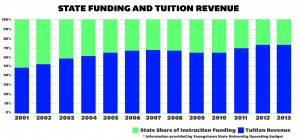 On Sept. 4, Youngstown State University reported their official 14-day enrollment numbers at 12,551 students — a 6.3 percent drop from fall 2013 enrollment numbers. Though the decrease was .2 percent better than expected from the preliminary enrollment numbers, it is still one of the sharpest decreases in YSU’s history.
On Sept. 4, Youngstown State University reported their official 14-day enrollment numbers at 12,551 students — a 6.3 percent drop from fall 2013 enrollment numbers. Though the decrease was .2 percent better than expected from the preliminary enrollment numbers, it is still one of the sharpest decreases in YSU’s history.
With this being the fourth consecutive year of enrollment decline, should YSU students expect another year of dropping enrollment and what is YSU doing to work toward climbing numbers in fall 2015?
Gary Swegan, the associate director of enrollment planning and management, said that when he arrived only a year ago in 2013, another year of enrollment decline was predictable, due to the economy — which had driven people to universities during the recession and has now improved and driven people to the workforce — the restriction of the university’s open enrollment policy and a host of other factors.
“I didn’t have to get here to look at the data; I have done this long enough. I knew — with three down years and the fact that the president at the time had just moved us to open admission to open access, just a fancy way of saying that we are now just a little bit selective — we were going to be down this year,” Swegan said. “This was a new world order. You know, the state-funding model has changed; we have just become moderately selective. You don’t know exactly what the impact is going to be, but I had, as I said, models that went all the way from 2.5 to 6.2 percent. Dunn, who at the time was still here, wasn’t about to hear a 6.2 percent.”
One of the most important steps to improving enrollment and overall conditions at the university is retaining students that are already at the university until graduation.
With the state-funding model now focusing on rewarding student success, graduation and retention rates are now of paramount importance in the distribution of state funding, causing YSU to drop significantly in the percentage of the budget composed of state funds. In fiscal year 2001, state funding composed more than 50 percent of the budget. Now, it makes up approximately 25 percent of the budget.
As a result, YSU has focused on targeting students with higher retention potential by tightening standards, hiring third-party enrollment groups like Royall & Company and improving the retention of current students.
Fortunately for the university, Jonelle Beatrice, executive director of Student Life, indicated that retention rates have actually risen.
“By retention, we mean measuring the first freshmen full-time students and seeing if they return for the following semester. Retention numbers have been steady and as of last week, retention has been up,” Beatrice said.
This sustainment of retention is likely due to YSU’s denial of the lowest achieving students, who typically had among the lowest graduation and retention rates.
“I keep making these new discoveries. Even though, to the general public, all it looks like is the sky is falling. I get that,” Swegan said. “Let’s take four years ago, it was the height of our enrollment. … If we take the students we denied admission to this year, and we go back to say ‘05 to ‘09, and we look at [similar students] … what do you think their graduation rate is? 1.2 percent.”
In order to ensure first-year student success — and subsequently increase retention — Beatrice encouraged students to frequently visit the Center for Student Progress on campus, meet with a peer mentor and seek weekly tutoring during their first year.
Cole Blakeley, a third year Supplemental Instruction leader for the Center for Student Progress, made positive comment on the university’s support services.
“One major factor in having success as a student is having resources that are necessary in promoting success,” Blakeley said. “Visiting with your peer mentor and making connections for first-year students will aid in achievement for the rest of your college career. There are also study sessions for challenging classes that provide support, extra study time with well engaged tutors.”
Blakeley also noted that by providing students with extra tools for success helps them perform better on exams and decrease the dropout rate. Students who visit the CSP weekly have a retention rate of around 70 percent.
Between increased retention efforts and new methods to attract strong, new students, YSU hopes to begin fall 2015 swinging.
Additional reporting by Liam Bouquet.